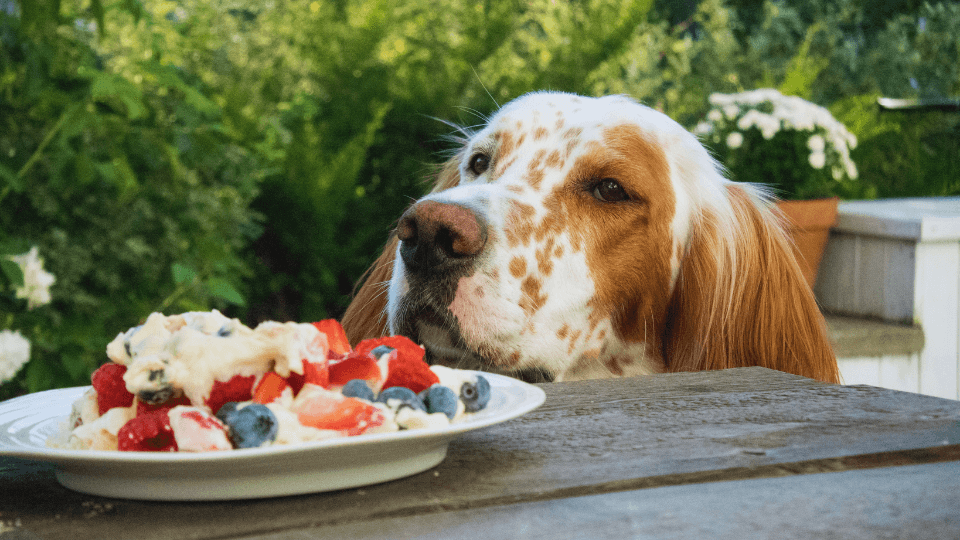If you’re concerned your dog has eaten something toxic or harmful, contact your veterinarian or the Pet Poison Helpline immediately at (855) 765-7661.
Pet parents often enjoy sharing a bite of food with their best four-legged friends - but you should always pause and ask, “Is this safe for dogs to eat?” before feeding your loved one something potentially toxic.
Although dogs can eat many things perfectly fine, there are several foods suitable to people that are highly poisonous to pets. In 2020 alone, the ASPCA Animal Poison Control Center (APCC) received over 370,500 calls from concerned pet parents - that’s more than 1,000 calls per day - with 13% of cases attributed to human food.
Unfortunately, accidental pet poisoning may be more common than you think. Use this list to learn about safe and unsafe food for dogs to eat, so you can avoid feeding Fido anything that could impair their short- and long-term health.
Table of Contents:
- What human foods can dogs eat safely?
- What fruits can dogs eat?
- What fruits are unsafe for dogs?
- What vegetables can dogs eat?
- What vegetables are unsafe for dogs?
- Can dogs eat nuts?
- Can dogs eat grass?
- What foods are toxic to dogs?
- Key Takeaways
What human foods can dogs eat safely?
The best foods for dogs should meet canine nutritional requirements and steer clear of unnecessary additives, like processed sugar. According to the National Research Council, essential nutrients in a canine diet include protein, carbohydrates, vitamins, minerals, fatty acids, and water.
-
Historically, dogs consumed protein from animal meat, but most pets now satisfy their protein requirement through commercial-grade dog food. Apart from kibble, dogs can eat most types of lean meat, but you should always trim off any fat that may be present because it can contribute to weight gain, diabetes, and pancreatitis. Be careful when serving raw meat to dogs, as it may be contaminated with bacteria known to make pets (and people) sick.
Also, make sure to remove the bone before serving meat to dogs, as animal bones are a choke hazard that can get caught in their throat or digestive tract, leading to a number of potential problems. Avoid giving dogs cooked bones because they can splinter and puncture the roof of their mouth or tear the intestinal wall, leading to expensive emergency vet treatment.
-
Today, most dogs consume carbohydrates (carbs) through grain added to kibble, such as wheat, rice, oats, corn, barley, millet, oatmeal, and quinoa. The American Kennel Club (AKC) confirms these are all safe for dogs to eat, although there has been recent debate over the value of grain-free diets for dogs.
-
Many fruits and vegetables contain vitamins and minerals dogs need for optimal health. Some plant foods are also sources of protein and healthy carbs. Others, such as watermelon and celery, can be very hydrating due to their high water volume, which can be especially helpful to feed dogs who rarely drink water from a bowl.
-
Dogs cannot produce fatty acids (omega-3 and omega-6) on their own, so they must consume them through their diet. Apart from oily fish, nut and seeds are the best sources of omega fats.
However, as you'll see in the sections below, not all fruits, vegetables, and nuts are safe for dogs to eat. We’ll take a look at some of the best and worst foods for dogs, so you can avoid the cost of an emergency vet visit and promote your pet’s ultimate wellness.
What fruits can dogs eat?
Canines are (mostly) carnivores and fruits aren’t a necessary part of their diet, so you shouldn’t serve them to dogs too often. That said, many fruits can make a great, tasty treat for dogs on occasion.
Here are a few of the best fruits to feed dogs when you want to give them something special:
Apples
Dogs can eat apples but first remove the stems and seeds, then cut the apple into slices before serving.
Bananas
Dogs can eat bananas in moderation, but this sweet fruit is rather high in sugar.
Blueberries
Packed with antioxidants, dogs can eat blueberries and enjoy many of the same benefits the fruit offers to humans. They’re low in calories and make for healthy training treats.
Cantaloupe
Melons like cantaloupe are very high in sugar, so only give them to your dog on rare occasions.
Cranberries
Both fresh and dried cranberries are safe to feed to dogs in moderation. Cranberries are also high in antioxidants, helps to reduce inflammation in dogs, and boost the canine immune system.
Cucumbers
Cucumbers are technically a fruit that’s low in calories and high in water content. These are excellent, thirst-quenching treats for dogs, but feeding them an entire cucumber is inadvisable. Also, be sure to chop the fruit into bite-sized pieces to prevent your dog from choking.
Mango
Dogs can eat mango as a special treat from time to time, but they’re also high in sugar and should be fed in moderation. Always remove the hard pit before serving to avoid a choking hazard.
Oranges
Rich in vitamin C, dogs can eat oranges so long as the seeds and peel are removed because they can be rather harsh on their digestive tract. However, they may not enjoy the strong, citrusy scent and choose to leave the served slices alone.
Peaches
Dogs can eat peaches from the fresh produce section once the pit has been removed, but avoid canned options because they tend to come in sugary syrup.
Pears
Pears without the stem and seeds are safe for dogs once cut into bite-sized pieces. According to the American Kennel Club, eating pears may even reduce the risk of stroke in dogs by 50%.
Pineapple
Dogs can eat pineapple after you remove the skin and crown. This tropical fruit is made up of 82% water, so it can help keep your dog hydrated during the hot summer months. Try serving pineapple to dogs in frozen, cubed pieces mixed in with their food from time to time.
Raspberries
Raspberries may be fine in moderation, but they contain natural xylitol, which can be toxic to dogs in high doses.
Strawberries
Strawberries are another good source of vitamin C and okay for dogs in moderation, but they are higher in natural sugar than other fruit options and present a choke hazard if swallowed whole.
Watermelons
Dogs can eat watermelon as a healthy, hydrating treat, but be sure to remove the rind and the seeds before serving.

What fruits are unsafe for dogs?
While many fruits contain nutrients beneficial to dogs, most all are naturally loaded with sugar that can lead to obesity and secondary health problems if eaten too often. However, there are some fruits that pose additional health risks in dogs and are generally better to avoid altogether:
Avocado
Although some dogs can eat avocado flesh without problems, the pit contains a fungicidal toxin called persin. Canines are more resistant to persin than other animals, such as birds and horses, but it’s not entirely risk-free.
Cherries
The pits of cherries contain amygdalin, which is converted into cyanide when crushed or chewed before being ingested. Humans should never eat a cherry pit, and dogs should never eat cherries.
Grapes
Grapes and raisins (dried grapes) are very toxic for dogs. They can even lead to acute kidney failure in some cases.
Tomatoes
The leaves, stem, and green parts of tomatoes and similar plants within the nightshade family contain a substance called solanine that is toxic in canines. Although dogs can eat tomato flesh that’s red and ripened, the risk of other parts of the plant reaching your dog’s mouth makes tomatoes too dangerous to consider.
What vegetables can dogs eat?
Many commercial dog foods contain vegetables, but not all vegetables are safe to serve raw or cooked. If you’re thinking about feeding Fido something green, here are your safest options:
Broccoli
Dogs can eat broccoli in small amounts, as it contains many healthy nutrients and is not considered toxic to dogs. However, make sure your dog doesn’t eat the stalk because it can get caught in their throat. Broccoli also contains a group of chemicals called isothiocyanates which can cause gastrointestinal (GI) irritation in some dogs, so you should monitor their behavior after feeding for the first time.
Brussels Sprouts
Brussels sprouts are packed with nutrients, but they’re known to make dogs extra gassy and served best in moderation. The same rules apply to other types of cabbage within the brussel sprout family.
Carrots
Low in calories but filled with fiber and beta-carotene, dogs can eat carrots in larger quantities than other types of vegetables. Baby carrots make for great, occasional treats and many dogs enjoy the crunchiness when chewing.
Celery
Like carrots, dogs can eat celery with a satisfying crunch and absorb the many vitamins and minerals the plant has to offer. Try freezing them during the summer and swapping a stick out with one of their favorite chew toys.
Green Beans
Dogs can eat green beans any way you prepare them, but they might experience stomach upset if they consume strong seasoning. Be careful with canned green beans, as they may contain excess sodium.
Peas
Dogs can eat peas in every variety, including snow peas and sugar snap peas. Similar to green beans, these are also better to serve cooked fresh to minimize the salt intake from canned options.
Spinach
Dogs can eat spinach as well, but this leafy green shouldn’t be a go-to vegetable because it contains oxalic acid. According to the ASPCA Animal Poison Control Center of Urbana, Illinois, soluble oxalates block your dog’s ability to absorb calcium. Although your dog would need to eat a significant amount of spinach for it to cause an issue, it’s always better to err on the side of caution.

What vegetables are unsafe for dogs?
Canines have a hard time digesting vegetables, so they should all be given as a healthy snack in moderation to avoid GI upset. Some vegetables are more problematic than others, so use extra caution with the following:
Asparagus
Asparagus isn’t toxic to dogs, but raw asparagus is too tough to be eaten raw and cooked asparagus doesn’t contain enough nutrients to make it worth the effort.
Mushrooms
White mushrooms from the grocery store that have been washed may be okay to give your dog, but it’s best to avoid mushrooms altogether because many wild mushrooms are toxic to both humans and dogs.
Onions
Dogs cannot eat garlic, leeks, chives, onions, or any member of the Allium family of plants. Allium plants are especially poisonous to cats, but they can still cause diarrhea, vomiting, and severe food poisoning in dogs.
Can dogs eat nuts?
While many fruits and vegetables offer safe, healthy alternatives to store-bought treats, there are few types of nuts safe for dogs to eat. They may provide fatty acids, but most have an excessively high-fat content that can lead to weight gain upon regular consumption. Many types of nuts are simply not suitable for your dog to eat because they can lead to blockages, choking, and other physical hazards.
Keep in mind that dogs cannot eat walnuts or pistachios because they can carry a mold that produces aflatoxin. This can cause severe damage to your dog’s body, resulting in potentially lethal liver failure. Also, never feed dogs macadamia nuts, which are naturally toxic to canines.
Most canine nutritionists suggest you go with fruits, vegetables, or lean meats when giving dogs human food as an occasional treat. However, if you want to toss a few to your four-legged friend during snack time, here are your best options:
Peanuts
Although they’re packed with calories, dogs can eat peanut butter in limited amounts. Be sure to pay attention to the ingredients listed on the jar so you can avoid products containing xylitol as an artificial sweetener. You should also never give dogs salted, candied, or caramelized peanuts.
Almonds
Dogs can eat almonds, a nut rich in vitamin E and magnesium, which promote heart health in canines. They also contain antioxidants for additional defense against damage caused by free radicals, as well as essential fatty acids. That said, the number of risks present when a dog eats almonds can outweigh the potential health benefits.
Cashews
Dogs can eat cashews in moderation, so long as they’re shelled, unsalted, and unmixed with other nuts that are hazardous to canines. Cashews contain protein, fiber, antioxidants, vitamins, minerals, and omega-3 fatty acids.
Chestnuts
Roasted chestnuts typically make an appearance around the holidays, and dogs can safely indulge in a couple. They contain some minerals, such as potassium and iron, that are beneficial to dogs, but like most nuts, chestnuts are very high in fat. They can also be harsh on your dog’s digestive tract if they eat too many of them.
Can dogs eat grass?
In general, grass isn’t particularly harmful to dogs, but the pesticides and herbicides sprayed onto grass can be toxic. Your pup may also ingest parasites like hookworms if they eat grass contaminated by animal feces.
Eating grass is a common behavior among dogs, but there’s a lot of debate around why they do it. Some veterinarians believe it could be due to deficiencies in their diet, but even dogs with well-balanced diets occasionally eat grass.
Many pet owners believe their dogs eat grass because they feel sick to their stomach, but there’s no hard evidence to support this. Many dogs that eat grass tend to vomit afterward, but the grass could be what causes an upset stomach in the first place.
To prevent your dog from eating grass, try distracting them with treats whenever they lean down to take a bite out of the lawn. If your dog continues to eat grass or seems to do so compulsively, ask for a professional opinion from your vet, as it may be a sign of a deeper problem.
What are foods are toxic to dogs?
Several substances are highly toxic to canines. Be extremely careful and never allow your dog to consume alcohol, caffeine, or chocolate.
Chocolate is poisonous to dogs, although the type of chocolate and the amount that was consumed plays a factor. White chocolate isn't nearly as toxic as dark chocolate, but it still contains enough fat and sugar to make your dog sick.
According to Hill's Pet Nutrition, "The toxic component of chocolate is theobromine. Humans easily metabolize theobromine, but dogs process it much more slowly, allowing it to build up to toxic levels in their system." A larger dog can also consume more chocolate than a smaller dog before suffering negative effects.
Here is a recap of the most dangerous things that dogs should never consume:
- Alcohol
- Caffeine
- Cherries
- Chocolate
- Grapes
- Macadamia nuts
- Garlic
- Walnuts
- Xylitol
Protect Your Dog with Pet Insurance
Pet insurance can help you avoid a large vet bill if you have to go in for an emergency visit due to accidental food poisoning. It can give you peace of mind by knowing that no matter what happens, your pet will have access to gold-standard veterinary care.
Find the best pet insurance plan for your canine companion today so you can enjoy policy coverage as soon as possible.
Key Takeaways
- It's best to serve dogs food containing nutrients found in their natural diet, so keep them away from junk food and sugar.
- Although some fruits naturally contain high volumes of sugar, they can be safe and healthy dog treats in moderation.
- Vegetables are nutrient-dense but may be difficult for dogs to digest, so only serve them in moderation.
- Stick to lean meats and fruits or veggies before adding nuts to a dogs diet, as the high fat content could lead to weight gain and obesity.
